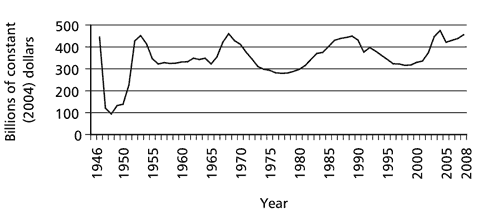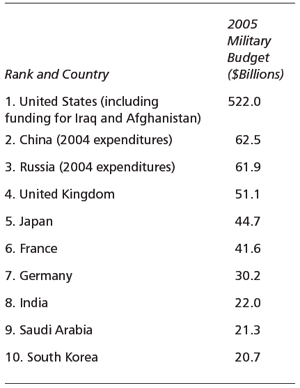Economy in Numbers
U.S. Military Spending and the Cost of the Wars
This article is from the July/August 2006 issue of Dollars & Sense: The Magazine of Economic Justice available at http://www.dollarsandsense.org

This article is from the July/August 2006 issue of Dollars & Sense magazine.
Subscribe Now
at a discount.
For the past several years, the annual inflation-adjusted budget of the Department of Defense has been higher than the Cold War average of $342.4 billion per year (see Figure 1).
FIGURE 1: U.S. Military Spending, FY 1946-FY2008

Note: Figures for 2007 and 2008 are projected.
Sources: Center for Defense Information, U.S. Military Spending, 1945-2008.
The peaks in the early 1950s, the late 1960s, and the mid-1980s reflect spending on the Korean War, the Vietnam War, and the Reagan military buildup respectively. With the United States at war in Iraq and Afghanistan, it might not seem surprising that Defense Department spending is again at a peak. But that's not the explanation: the DoD's regular budget, shown in Figure 1, does not include direct spending on those wars. Add in the special appropriations Congress has made to cover the costs of war-fighting since 9/11, and the current military buildup is even more dramatic (see Figure 2).
U.S. military spending, including spending on the wars, is far and away the highest in the world, dwarfing the next nine top spenders combined (see table).
One of the only countries to spend a comparable amount per capita on its military is Israel, whose population is comparable to that of Massachusetts. U.S. military spending per capita is $1750; Israel's is $1380. Russia spends $432 per capita; China spends $47.
TABLE: Top Ten Military Spenders, 2005

Sources: Center for Arms Control and Non-Proliferation, "U.S Military Spending vs. the World," February 6, 2006, www.armscontrolcenter.org/archives/002244.php (see also www.sipri.org/contents/milap/milex/mex_trends.html).
The money the Defense Department has spent on the Iraq war does not exhaust the costs of the war to the government. In a study released last February, Harvard policy analyst Linda Bilmes and Columbia economist Joseph Stiglitz estimated that if we include spending by the Veterans Administration, demobilization costs, and interest on debt incurred because of the Iraq war, the cost of the war to the U.S. government rises to between $750 billion and $1.2 trillion. If we add in economic costs that are not borne by the government—e.g. the lost economic contributions of reservists while they are deployed, or after they are dead or injured—the price tag for the war balloons by another $187 billion to $305 billion.
Bilmes and Stiglitz also attempt to estimate the larger macroeconomic costs of the Iraq war. One source of such costs is the higher price of oil—now over $50 per barrel, vs. $25 per barrel before the war—plausibly due to instability in the Middle East resulting from the war. They argue that even assuming, conservatively, that only 10-20% of the increase is due to the war, this translates into a $25-50 billion dollar added expense. Addressing a number of other possible consequences of the war—increased security threats, higher interest rates, and opportunity costs of devoting so many resources to the war in Iraq—they conclude that even with conservative estimates, its macroeconomic costs "are potentially very large; possibly even a multiple of the direct costs," that is, possibly several trillion dollars.
FIGURE 2: U.S. Military Spending, Including Wars, 2002-2006

1. Operation Enduring Freedom "covering Afghanistan and other Global War on Terror (GWOT) operations ranging from the Philippines to Djibouti, that began immediately after the 9/11 attacks and continues."
2. Operation Iraqi Freedom "began in the fall of 2002 with the build up of troops for the March 2003 invasion of Iraq and continues with counter-insurgency and stability operations."
[Note: Figures for war spending in 2002 includes some spending from the end of 2001.]
Source: Amy Belasco, Congressional Research Service, The Cost of Iraq, Afghanistan, and Other Global War on Terror Operations since 9/11, updated June 14, 2006.
Bilmes and Stiglitz conclude by enumerating many other ways the vast sums going into the Iraq war could have been spent so as to "buy" greater well-being and more security than the war has achieved. They make a plea for governments to undertake cost-benefit analysis of a planned war before starting it: "The most important things in life—like life itself—are priceless. But that doesn't mean that topics like defense … should not be subject to cool, hard analysis of the kind for which economics has long earned a reputation."
The kind of analysis mainstream economics has a reputation for can certainly provide a balance sheet for a war. But as the figures above reveal, the U.S. government is accelerating military spending even apart from its actual wars. What mainstream economic analysis, with its categorical blindness to deployments of power in the political economy, cannot do is to explain why.
